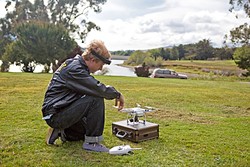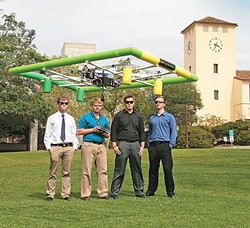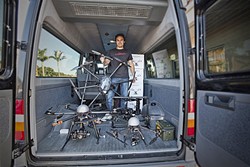Martin Bialy never expected to become a drone enthusiast.
About a year ago, Bialy’s uncle bought a basic Unmanned Aerial Vehicle (UAV)—as they are officially called—but didn’t know how to use it. So he loaned it to his nephew to figure out and then teach him.
During that time, Bialy grew attached, and now he can’t get enough airtime.

- PHOTO BY KAORI FUNAHASHI
- LAUNCH PAD : Martin Bialy unexpectedly became a drone aficionado; now, he is looking to see how he could turn it into a future business.
“I didn’t think I would like it even, but then I fell in love with it,” Bialy said.
When it was time to give the drone back to his uncle, Bialy decided to buy one for himself and purchased the high-end version of what his uncle had, a DJI Phantom 2 Quadcopter. Attached is a 3-Axis Gimbal that holds a GoPro video camera.
Bialy has flown remote control aircrafts since he was 11, starting with airplanes and helicopters. Back then, he said, the machines were much harder to use, and they were, in a way, limited to people who knew what they were doing. Now, the technology has become more approachable.
“It used to be hard to fly them, and now it’s easier, so anyone can do it,” he said.
Anyone, really, can build and operate a UAV, and the technology is proliferating quickly. For many, including Bialy, it’s a hobby now, and possibly a business in the future because the technology can be applied to so many things. It’s created a new frontier where the sky is the limit. Photography, filming, agriculture, law enforcement, and delivery services are just a handful of the fields in which UAV capability can be applied. Companies and agencies across the Central Coast are clamoring to get in on the California drone rush—and lawmakers and advocates are taking notice.
The future is here
On Feb. 15, the Federal Aviation Administration released its long-awaited proposed rules on commercial drone use. The regulations would allow operators to fly drones weighing up to 55 pounds during daylight hours, within line of sight, no faster than 100 miles per hour and less than 500 feet above ground. The operator must also be at least 17 years old and pass an aeronautics test.
The newly proposed FAA rules concluded a public comment period in April. Although they apply nationwide, the regulations also leave states the room to devise their own drone rules.
State Sen. Hannah-Beth Jackson (D-Santa Barbara) said she believes California’s privacy laws need to be strengthened against drones, and her reasoning comes from personal experience.
She had an unexpected firsthand encounter with a drone in December 2014 while vacationing in Hawaii. She recalled having some morning coffee with her husband in the backyard of their home when a flying drone came buzzing over the property line. It hovered for about three minutes, staring “eyeball to eyeball” with her husband from 15 to 20 feet away, she said.
A little shocked at the invasion of their personal space, both Jackson and her husband followed the drone as it flew away. The operator turned out to be a friendly—albeit curious—neighbor from a few houses down. The thought of a high-tech Peeping Tom didn’t sit well with Jackson.
“It was a startling invasion of privacy,” she said. “There are really no provisions that address this technology in situations like this.”
The unnerving experience inspired Jackson to write Senate Bill 142, legislation that seeks to amend the state’s privacy laws to include drones. Introduced in January, the bill calls for trespassing charges if a UAV crosses a private property line up to about 350 feet in the air, which is below federally recognized (and therefore, federally regulated) navigable airspace.
But this is where things begin to get complex.
Greg McNeal is a professor of law at Pepperdine University and has written extensively about public policy regarding drone use. He said Jackson’s bill would basically be unenforceable the way it’s written. In a Forbes article written on Feb. 16, McNeal explained that the FAA definition of navigable airspace is “anywhere an aircraft can operate,” which includes the space immediately off the ground.
Since drones are also considered to be aircraft, McNeal believes that drones flying above someone’s property aren’t trespassing because they’re within that navigable airspace allowed by federal law. McNeal said he agrees with the bill’s approach to what he believes is extending property lines to the air, but he argued that Jackson is using the wrong terminology.
“She simply can’t make reference to ‘navigable airspace,’” McNeal told New Times. “Drones will be authorized to fly from the ground up to 500 feet.”
The solutions to this quandary of verbiage, McNeal said, are to strike the term navigable airspace and designate a minimum height drones could be regulated to at the state level. As originally pitched, SB 142 was aiming to make that limit 400 feet. Now, it’s down to 350 feet.
“I think 350 feet is the right altitude,” McNeal said.
Jackson acknowledges McNeal’s issue with her bill, and said she’s still working out the details of her legislation. The bill passed the state Senate and is currently heading to committee in the state Assembly.
1984?
While Jackson fights for privacy rights, two other state senators want to give police the power to use drones in emergency situations.
State Sens. Joel Anderson (R-Alpine) and Cathleen Galgiani (D-Stockton) introduced SB 262 in February, which would specifically give a law enforcement agency the power to use UAVs, as long as doing so complies with the Fourth Amendment.
The California Police Chiefs Association—whose board of directors until not long ago included the recently ousted San Luis Obispo Police Department Chief Stephen Gesell—is backing the bill.
San Luis Obispo Police Department Acting Chief Chris Staley—who was captain when he spoke to New Times for this article—commands the countywide Special Weapons and Tactics team. He’s been tracking the technology and wants it for tactical and surveillance uses during standoffs.
“We definitely think it could give us an advantage in those situations—if not give us real-time information of, let’s say, what a backyard would look like,” Staley said, adding that police are still waiting for more guidance on drone use. “We’re just kind of waiting to see how it shakes out before we go down that road.”

- PHOTO COURTESY OF CAL POLY
- BARGING FORWARD: The Cal Poly SkyBarge Team—(left to right) Gordon Belyea, Garret Gudgel, Ethan Juhnke, and Eric Dreischerf—took second place in November 2014 at the American Society of Mechanical Engineers Student Design Competition in Montreal.
At this time, San Luis Obispo County Sheriff Ian Parkinson isn’t considering using drones in his department.
The prospect of police drones can evoke a sense of Orwellian paranoia in some people. Anderson and Galgiani’s bill, despite the written-in promise of protections for civil liberties (the Fourth Amendment, specifically), may not go far enough to satisfy everybody.
“It’s a null statement,” said Jeremy Gillula, a staff member with the San Francisco-based nonprofit Electronic Frontier Foundation, which advocates for technological civil liberties. “Police already have to comply with the Constitution.”
Although the bill mentions protections against unreasonable searches and seizures guaranteed by both the U.S. and California constitutions, Gillula contends that having something specifically requiring police to obtain a warrant should also be written into the bill.
Sen. Anderson still thinks the bill is sufficient. In an email to New Times, he wrote that SB 262 “balances innovative technologies with the Fourth Amendment” and “forces unmanned aircraft systems not to exceed current laws.”
“They should put in the bill that you need a warrant and you need probable cause,” Gillula emphasized, adding that a bill such as AB 1327 would have been better.
Republican Assemblyman Jeff Gorell, who represents the state’s 44th District in Ventura County, introduced AB 1327 in February 2014. It would have generally prohibited public agencies from using UAVs, except for certain exceptions. The bill also would have subjected any data collected via UAV, including images and footage, to California public records laws.
AB 1327 didn’t make it, though. Gov. Jerry Brown vetoed the bill in September 2014.
Gillula also takes issue with Jackson’s bill, saying it’s way too vague and doesn’t include provisions for drones that have nothing to do with surveillance.
“If someone wanted to do air quality monitoring,” Gillula says, “it would have to fly above someone’s house, even if it doesn’t have any cameras.”
Don’t call it a drone, man
A drone is essentially a remote-controlled aircraft, but calling that machine a “drone” can be a bit contentious. Enthusiasts prefer to use either the term UAV, FPV (first person view—with the camera attached), or UAS (unmanned aerial system), which encompasses the vehicle and the control system.
The distinction comes in terminology, according to Ryan Jenkins, an assistant professor of philosophy at Cal Poly who studies the ethics of emerging technologies. A radio-controlled aircraft with a specific purpose—be it altruistic or commercial—would be considered a drone or UAV.
When people think of drones, he explained, they typically picture something that can fly—but that’s not always the case. The term can encompass much more than aerial machines, and pinpointing a definition is a big deal, he said.
“It’s becoming increasingly important now because aircraft that are fully autonomous are being developed, and it’s a very hot topic,” he said. “You are starting to see things that are living up to the label of drone with the military and ethicists.”
He refers to remotely piloted, autonomous vehicles being developed for use in places other than the air. In January 2014, the U.S. Navy announced a type of underwater gliding drone that uses a process called hydraulic buoyancy. The Navy awarded a $203,731 contract to the Massachusetts-based company Teledyne Benthos to develop the technology.
But is it a drone or a robot?
“That’s the problem,” Jenkins said. “When you say ‘drone,’ people think of a robot. I think [of] a drone as something you can give a pre-programmed order without any sort of human oversight. That’s why it’s important that the drones the military’s using always have a human at the switch.”
Jason Lee owns and operates Sky Pirate, a shop in Pismo Beach that sells, among other things, drones. He said that many enthusiasts take issue with the word because it evokes images of the hunter-killer Predator UAVs used by the Air Force. Despite this connotation, he still uses the term.
“It’s what everyone’s using,” he said. “That’s what I’m using.”
Leading the research
In the Cal Poly aerospace engineering department, professor Aaron Drake uses the term unmanned aircraft to refer to flying drones. He’s leading what he calls the “applications of autonomous flight initiative,” the purpose of which is to bring more research and content into the curriculum, he said. Drake has decades of experience in the development of unmanned aircraft.

- PHOTO BY DAVID MINSKY
- SELLING DRONES: Jason Lee sells Unmanned Aerial Vehicles (UAVs) for as little as $40 at his shop, Sky Pirate, in Pismo Beach. He believes that the rapid proliferation of drones demonstrates a need for regulations to govern their use.
The field is nothing new, he explained, but the biggest recent advancement has come from how the machines are controlled.
“Unmanned aircraft have been around since the 1920s,” Drake said, “but the guidance and control aspects have been very rudimentary.
“The biggest advancement has come from the control side,” he said. “In the last couple of decades, you’ve been able to install sophisticated computerized controls.”
On the more practical side, a team of Cal Poly students developed something they call the “SkyBarge,” a UAV that took second place at the American Society of Mechanical Engineers Student Design Competition held in November in Montreal.
At last year’s competition, the purpose was to build a fire-fighting UAV that can drop a payload and maneuver through an obstacle course. Looking like something out of a Jules Verne novel, the SkyBarge is constructed with aluminum, foam, electronic parts, and several feet of PVC piping; the green and yellow rectangular-shaped aircraft flies with eight propellers. It takes several hours to assemble, said SkyBarge project team leader Gordon Belyea. Starting in November 2013, the project took him and his team several months to design and build.
“There wasn’t necessarily an interest in drones, but this competition has given me a better appreciation for them,” Belyea said, adding that he’s dedicating his senior project to drone research.
The Wild West
Research and proposed regulations are evidence of the increasing popularity of drones and the applications they can be used for. Business is booming for entrepreneur and Santa Ynez-based pilot Chris Kunkle. He owns AeroOptix, a company that provides UAV aerial photography.
Kunkle’s company lands several jobs each week to film and photograph weddings, houses, and commercials.
“We’ve been getting really busy, four to five projects a week,” he said. “Everything is word of mouth so far.”
Bialy, who’s uncle got him hooked on drones and has an aeronautical engineering degree from Cal Poly, currently works at a company that builds flight simulators and is seeing the same sort of business boom—he’s currently considering contracting out with real estate companies to create aerial videos of estates to be used for marketing. Doing so would bring him into the commercial realm, which means several more restrictions and the requirement for a very expensive license.
Bialy has goggles that broadcast live footage from the GoPro camera on his drone, enabling him to fly the drone over distances and see where it’s going. He acknowledges that while the FAA rules may limit the fun for some enthusiasts, they’re necessary. One possible rule is that drones must be in sight at all times for their operators, rendering his virtual-reality-like goggles not as useful as they could be.
For Sky Pirate’s Lee, the FAA’s proposed regulations could be “workable.” With UAVs selling for as little as $40 in his shop, anybody could buy one with their own purpose in mind.
“You got to have rules,” he said. “It can’t just be a free-for-all.”
Drones in the news
• In July 2014, numerous media outlets reported a crashed drone with marijuana, cigarettes, and cell phones found near the security fence at Lee Correctional Institute near Bishopville, S.C.
• In January 2015, a tweet popped up on the Twitter account for Tijuana’s Public Security Secretary, reporting the discovery of a crashed UAV packed with 6 pounds of methamphetamine near the San Ysidro crossing of the California/Mexico border.
• A DJI Phantom quad-copter drone reportedly crashed onto the White House lawn in January 2015. The New York Times reported that the operator, an allegedly drunk off-duty employee with a government intelligence agency, was responsible for the incident. Recently, the Secret Service in Washington, D.C., announced that it will begin flying drones near the White House.
• Theodorus Van Vliet, a Dutch tourist, crashed a drone into the Grand Prismatic Spring in Yellowstone National Park in August 2014, the Jackson Hole News and Guide reported, with the potential to disrupt the spring’s ecology. The U.S. National Park Service bans the use of drones in its parks. The newspaper reported that Van Vliet pleaded guilty and was fined $1,000.
Contact David Minsky, staff writer for New Times’ sister paper to the south, at [email protected]. New Times Staff Writer Jono Kinkade contributed to this article.
Comments